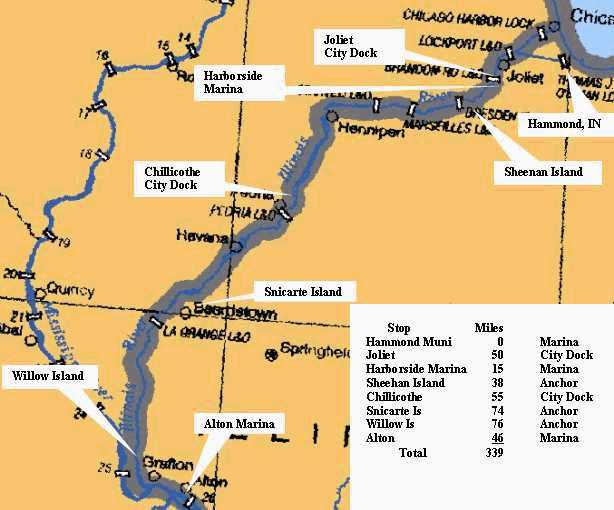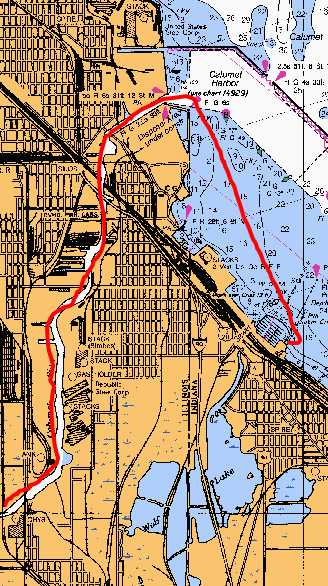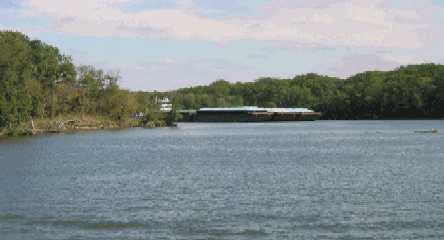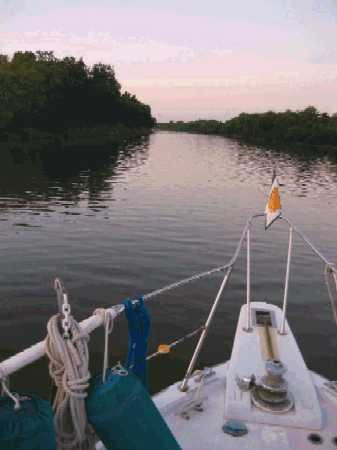

| There are two ways to get out of Lake Michigan at Chicago. One is through
downtown Chicago on the Chicago River. Unfortunately for us, there is at
least one fixed bridge with a clearance of only 17 feet. At our best, after
I have taken the dingy hoist down, we can maybe clear 17' 7" - not good
enough.
The other way is via the Calumet River through East Chicago. Part of this route is the Cal-Sag - dug decades ago to send treated (and maybe not) wastewater from Chicago to the Illinois and then to the Mississippi. As you can see from the first chartlet, they come together above the Lockport Lock & Dam. Below this point we will come to the make/break part of the 'Great Loop'. There is a fixed railroad bridge with a clearence of 19'1". If you can't get under it, you can't go! We came out of the Hammond, IN municipal marina and up 2 miles to the entrance to the Cal-Sag. Just around the first bend of the river was a bridge with an 18'4" clearance, the shortest until Joliet. I had been worried about whether we had reduced our height enough. Not to worry! It was already open!
|
 |
Then we came to the junction of the Chicago River and things got interesting
again!
 |
 |
We went through about 10 miles of a barge fleeting area that looked only 5 barges wide.
All this in the first day!!!
We also stopped at the Chillicothe city dock. It was a 100' floating
dock at the foot of a boat ramp - no power or water but a convenient stop.
We were really fortunate here. Dick Gamble, a transplanted Louisianian,
saw us starting out to the grocery with the little red cart and said 'take
my pickup...the good Kroger's is that way about 2 miles'. What a gift!!
We were to provision well enough to get to Alton, Il, our next big stop.
As an example, at Lockport, the first lock we hit, the upbound tow had pushed 6 barges into the chamber when we got there headed down. He then backed out of the chamber, the lock doors were closed, and the barges were lifted up. The locktenders attached a cable to the string and pulled it completely out of the lock, plus about 50 feet.
We were lucky. The lockmaster then instructed us to come around behind the last barge that had just been lifted up and enter the lock.. The water was drained out to lower us down to where the tow was waiting with the rest of the string. We had about a 25' gap between the lock wall entrance and the front of the first barge. We were off, the tow pushed in, he was lifted up, reconnected and was off. This evolution took probably about 1.5 hours of the tows time. If we were to showup at the lock at the wrong time it could cost us that 1.5 hours as well. It is not unheard of to have to wait 2 hours or more at a lock. On the otherhand, I called the LaGrange Lock about 20 minutes out and said I was coming their way. They opened the lock doors as we were approaching, we motored in, they closed them, lowered us down, opened the doors, and we were gone. The entire lockdown took 15 minutes.
Our ideas about the ideal place to anchor seem to be (for now):
Well, the anchorages we found have many of these attributes.
 |
 |
 |
|
|
|
|
Till Later!!
| Previous Issue (Number 17) | Home | Next Issue (Number 19) |